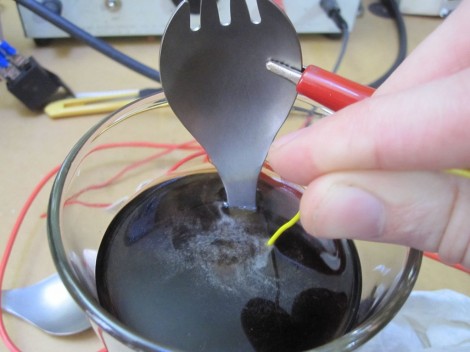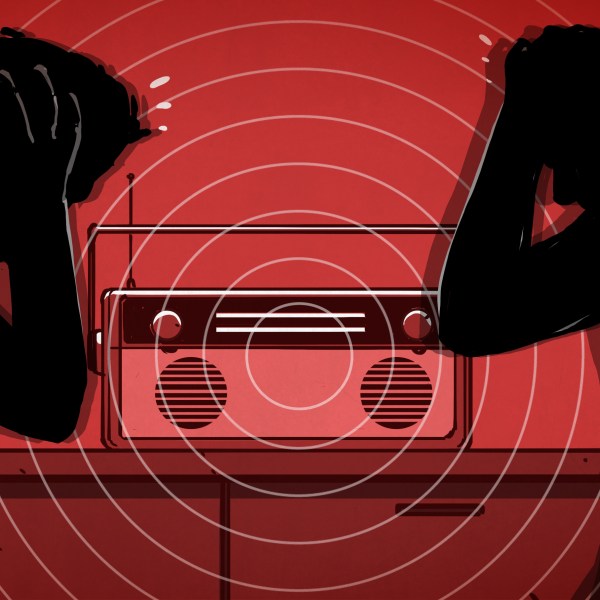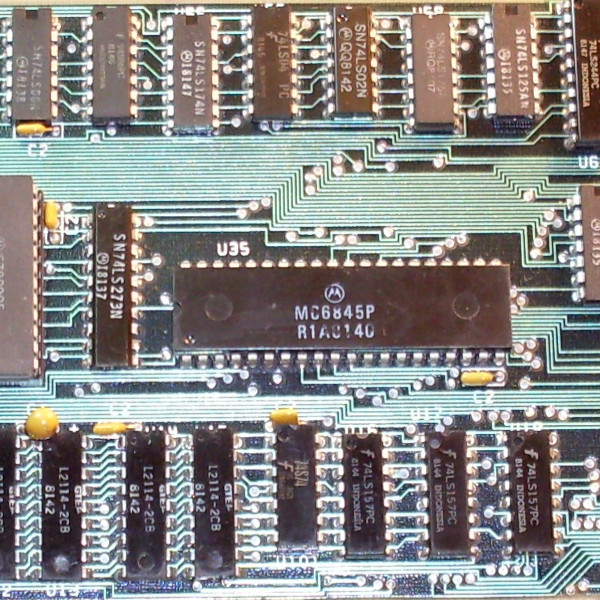
We don’t really have any titanium lying around, it’s not exactly a cheap material. But this hack that shows you how to anodize titanium in your home laboratory (or kitchen for that matter) and it might help the metal make its way into a future project. It seems the process is not overly difficult or dangerous and it’s possible to achieve a lot of different colors in the finish.
In the image above [PinkFlute] is using Coke Zero, a sugar-free soda, as the chemical agent in the process. The alligator clip attached to the utensil is providing the positive voltage and the yellow wire dipped in the drink is negative. Finish color is determined by the voltage supplied. You can choose various shades of green, purple, yellow, and blue based on a voltage range of about 100V to 20V.
This is one of two anodizing methods shown. the other uses a foam brush dipped in soda with the negative lead clamped onto it. You just brush in the electrified substance to alter the camping spork’s finish.
[via Reddit]
















“100V to 20V” ??
100V to 200V maybe ?
About 10 to 150VDC is the range although with cola it tops off at about 100VDC.
Would you get similar results with Aluminum?
No, the closest you could get to is http://hackaday.com/2011/10/17/anodizing-and-dying-aluminum-without-battery-acid/.
Anodizing titanium introduces an interference effect only a few atoms thick – sort of how some insects create different “colors” without using dyes or pigments. You don’t need any dyes to achieve the effects on titanium – just the correct voltage (and enough amps per surface area). Anywhere from 10 to 150VDC will produce a large variety of colors. Anodizing aluminum requires dyes as well as many extra steps and time. Anodizing titanium can be done in seconds but aluminum generally takes hours.
You can also use baking soda (sodium bicarbonate). Do not use salt (sodium chloride) as it will liberate toxic chlorine gas.
http://www.candlepowerforums.com/vb/showthread.php?232345-Anodizing-Titanium/page2
May be helpful for more information on DIY methods.
Here is a REALLY great resource for anodizing titanium:
http://mrtitanium.com/interference.html
Lastly, a high resolution color chart that also compares sulfuric anodizing to soda anodizing (sulfuric is more vibrant):
http://www-personal.umich.edu/~bobden/bob_titanium.html
What’s the advantage to do this, besides coloring?
Mostly coloring.
Also the thicker oxide layer improves corrosion resistance a bit, but mostly aesthetic.
But…but..titanium is just about as anti-corrosive as one can get. In fact that is it’s main draw after weight to strength ratio.
I have about a pound of the stuff lying about and see no need to put a finish on the already pretty matte surface.
It is purely for aesthetic effect.
I would not use cola though. Bubbles are a big enough problem already. Anything that is mildly conductive will work fine. I use borax or TSP. Both are pretty harmless.
Oh yeah. When doing this make sure you are using an isolated DC power supply. Nothing like getting shocked.
Also for the cathode you should use another piece or titanium with as much surface area as possible. I usually use some turnings from my lathe.
I need more information, can I use Pepsi, Dr. Pepper, RC Cola, inquiring minds want to know!
The phosphoric acid in the coke line helps the process. In fact phosphoric acid is preferred and it happens that the coke and pepsi products have it. So look at the ingredients and make sure it has phosphoric acid. I don”t know about the elmon lime drinks.
I played around with this a while ago. I think you can use bicarbonate of soda too.
Bubbles weren’t too much of a problem, as you can tap the titanium to dislodge the bubbles, repeat a few times until there is an even covering.
You can also mask off areas of the titanium to get different patterns – the toner transfer method does work here. As mentioned, colour is dependant on voltage, and you can ‘overwrite’ a colour with a higher voltage, so if you mask off everything but the highest voltage colour, anodize the titanium, then mask off everything but the highest 2 voltage colours, anodize the titanium etc. etc.
yes we used coke zero, diet coke, and Sam’s Cola
http://theodoregray.com/periodictable/PopularScience/2005/08/1/index.html
I remember this article…
http://www.popsci.com/diy/article/2005-06/titanium-technicolor
The larger the piece, the more current it will need. It pays off to spend some time cleaning the piece beforehand to make sure it’s free of grease or oils. It’s fun to experiment masking with paint, too.
You can also use a flame (e.g. a blowtorch, an alcohol lighter…) to anodize Ti. You don’t have much control over the color that way, but the effect is nice anyway, and the anodization layer is thicker.
Heh, the last time I saw temperature based Ti anodizing it was on the bottom of an F-15…. Saw the DCC use an entire can of never dull to shine it back up. She was the wing commander’s crew chief, and that plane was freaking spotless. She’s also the only crew chief I’ve ever seen walk under the nose of an F-15E without ducking…
Titanium tubs are standard. But on the outside? Shiny titanium? Nonsense. Titanium can be a dangerous tool to rely on in an emergency solely because it cannot be shined or polished to a reasonable degree. Thus why backpackers and hikers do not rely on it for signaling methods.
+100 nerd points for using a spork :)
IT WORKS ON ALUMINUM
So far no one has addressed the true factor to anodize titanium successfully. Meaning great vibrant colors. The electrolyte used is almost insignificant. The titanium must first be etched with hydrofluoric ( not sure of spelling) acid (extremely dangerous and not recommended) Multi-etch is a much safer alternative, and is available from Reactive Metals Studio (Arizona) They will provide you with full instructions. You will be in awe of the colors attainable. HAPPY ANODIZING Tom
Gr8 Work group… The information is really good and helped me a lot. However, while trying finishing titanium we experimented a lot and nothing worked. This is the most cheapest and workable model. I suggest cleansing of material with Castic Soda first and then the anodizing process is to be initiated. Aesthetic effect is must as noone would buy shabby looking products.
Nickle plating is not appropriate on titanium, Vibratory and Centrifuge are way expensive and not good for precision products, Sand blasting is another expensive way out to finish it. Coke is cheapest one plus offers coloring options using voltage variations. Definitely my customers would love it